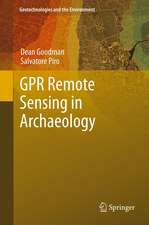Engineering Geology for Society and Territory - Volume 2: Landslide Processes
Editat de Giorgio Lollino, Daniele Giordan, Giovanni B. Crosta, Jordi Corominas, Rafig Azzam, Janusz Wasowski, Nicola Sciarraen Limba Engleză Hardback – 7 apr 2015
| Toate formatele și edițiile | Preț | Express |
|---|---|---|
| Paperback (1) | 2807.50 lei 38-44 zile | |
| Springer International Publishing – 26 iun 2017 | 2807.50 lei 38-44 zile | |
| Hardback (1) | 3196.58 lei 22-36 zile | |
| Springer International Publishing – 7 apr 2015 | 3196.58 lei 22-36 zile |
Preț: 3196.58 lei
Preț vechi: 3898.26 lei
-18% Nou
Puncte Express: 4795
Preț estimativ în valută:
611.67€ • 640.24$ • 509.10£
611.67€ • 640.24$ • 509.10£
Carte disponibilă
Livrare economică 10-24 martie
Preluare comenzi: 021 569.72.76
Specificații
ISBN-13: 9783319090566
ISBN-10: 3319090569
Pagini: 2324
Ilustrații: XLVII, 2177 p. 1567 illus., 1279 illus. in color. In 3 volumes, not available separately.
Dimensiuni: 210 x 279 x 128 mm
Greutate: 5.67 kg
Ediția:2015
Editura: Springer International Publishing
Colecția Springer
Locul publicării:Cham, Switzerland
ISBN-10: 3319090569
Pagini: 2324
Ilustrații: XLVII, 2177 p. 1567 illus., 1279 illus. in color. In 3 volumes, not available separately.
Dimensiuni: 210 x 279 x 128 mm
Greutate: 5.67 kg
Ediția:2015
Editura: Springer International Publishing
Colecția Springer
Locul publicării:Cham, Switzerland
Public țintă
ResearchCuprins
Part I Keynote.- Part II Advanced Landslide Field Instrumentation and Monitoring.- Part III Approaches to Landslide Risk Modelling and Mitigation.- Part IV Characterization, Monitoring and Modelling of Large Slope Instabilities and their Interaction with Engineering Structures.- Part V Characterizing and Monitoring Landslide and Ground Deformation Processes Using Remote Sensing and Geophysics.- Part VI Debris Flows: Mechanics, Modeling, Mitigation Measures, Hazard and Risk Assessment and Management.- Part VII Deep-Seated Gravitational Slope Deformations: Innovative Multidimensional Approaches and Targeted Applications.- Part VIII Early Warning Systems for Landslide Hazard and Risk Management.- Part IX Earthquake-Induced Landslides.- Part X Failure Mechanisms of Large Rock Slopes.- Part XI Geotechnical Design and Assessment of New and Existing River Embankments.- Part XII Giant Landslides—Major Hazard from Rare Events.- Part XIII Hazard Mapping.- Part XIV Interpretation of Landslide Mechanisms for Risk Mitigation.- Part XV Landslide Dam: Formation and Stability.- Part XVI Landslide Forecast Using New Techniques and Early Warning Systems.- Part XVII Landslide Numerical Modeling.- Part XVIII Landslide Recognition, Early Warnings and Risk Management.- Part XIX Long-term Monitoring of Deep-Seated Gravitational Slope Deformations for Hazard Assessment and Mitigation.- Part XX Passive Seismic Methods for Unstable Masses Monitoring.- Part XXI Mechanisms of Initiation of Rapid Landslides.- Part XXII Numerical and Analytical Methods for Prediction of Landslide Deformation Evolution.- Part XXIII Monitoring and Modeling of Landslide Processes.- Part XXIV Numerical and Analytical Methods for Prediction of Landslide Deformation Evolution.- Part XXV Passive Seismic Methods for Unstable Masses Monitoring.- Part XXVI Prediction Methods for Rainfall Triggered Landslides.- Part XXVII Rapid Landslide Propagation: Physical and Numerical Modeling.- Part XXVIII Rapid Mass Movement ofRock.- Part XXIX Risk Analysis, Assessment and Management.- Part XXX Rockfall Protection.- Part XXXI Rockfall Risk Assessment and Management—Current Practice and Developments.- Part XXXII Slope Stabilization and Protection Measures: Concepts and Methods.- Part XXXIII Water in Slope Instability: Hydrological, Mechanical and Chemical Processes.
Textul de pe ultima copertă
This book is one out of 8 IAEG XII Congress volumes, and deals with Landslide processes, including: field data and monitoring techniques, prediction and forecasting of landslide occurrence, regional landslide inventories and dating studies, modeling of slope instabilities and secondary hazards (e.g. impulse waves and landslide-induced tsunamis, landslide dam failures and breaching), hazard and risk assessment, earthquake and rainfall induced landslides, instabilities of volcanic edifices, remedial works and mitigation measures, development of innovative stabilization techniques and applicability to specific engineering geological conditions, use of geophysical techniques for landslide characterization and investigation of triggering mechanisms. Focuses is given to innovative techniques, well documented case studies in different environments, critical components of engineering geological and geotechnical investigations, hydrological and hydrogeological investigations, remote sensing and geophysical techniques, modeling of triggering, collapse, runout and landslide reactivation, geotechnical design and construction procedures in landslide zones, interaction of landslides with structures and infrastructures and possibility of domino effects. The Engineering Geology for Society and Territory volumes of the IAEG XII Congress held in Torino from September 15-19, 2014, analyze the dynamic role of engineering geology in our changing world and build on the four main themes of the congress: environment, processes, issues, and approaches. The congress topics and subject areas of the 8 IAEG XII Congress volumes are:
- Climate Change and Engineering Geology
- Landslide Processes
- River Basins, Reservoir Sedimentation and Water Resources
- Marine and Coastal Processes
- Urban Geology, Sustainable Planning and Landscape Exploitation
- Applied Geology for Major Engineering Projects
- Education, Professional Ethics and Public Recognition of Engineering Geology
- Preservation of Cultural Heritage
Caracteristici
One out of eight IAEG XII Congress volumes on the occasion of the 50th anniversary of IAEG Includes contributions of numerous worldwide renowned scientists Gives a thorough overview on landslide processes Includes supplementary material: sn.pub/extras












